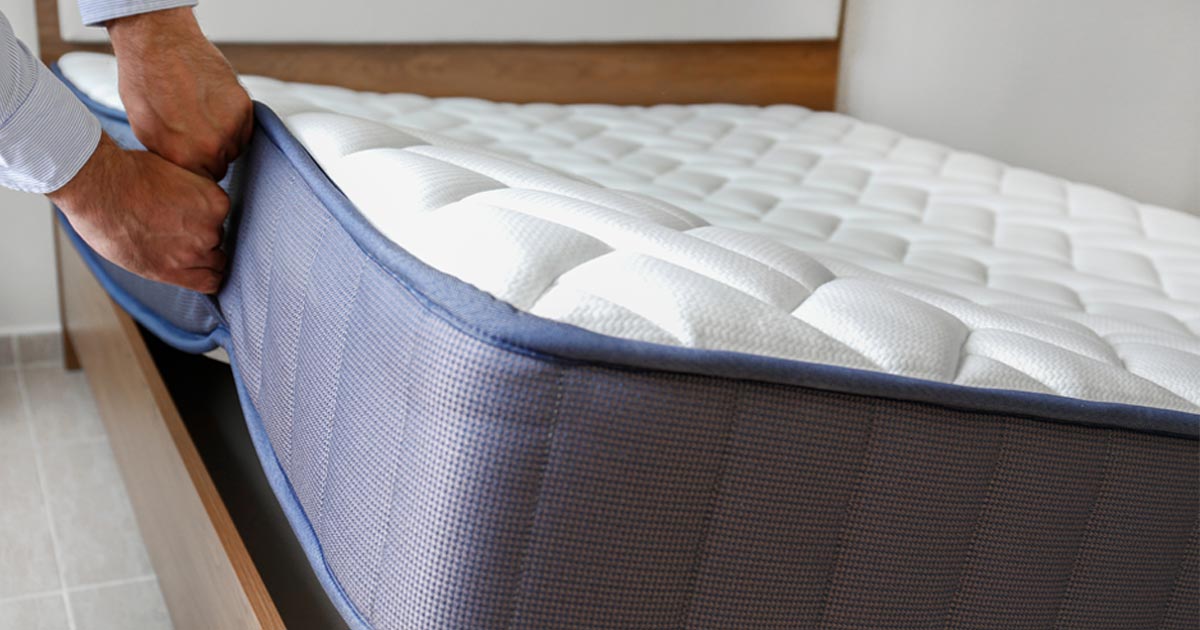Is Your Bed Sinking In the Middle? Know How to Fix A Sagging Mattress!
Is your mattress no longer as comfy as it used to be? Have you noticed any sagging in the places where you spend the most time sleeping? Mattress owners frequently express their dissatisfaction with sagging. All mattresses ultimately sink, and the feel and comfort of the bed will suffer as a result. There are a few things mattress owners may do to assist reduce the effects of mattress sagging.

What Makes a Mattress Sagging?
Normal wear and tear on your mattress is the most common cause of sagging. Mattress foam materials soften over time as they are subjected to tremendous pressure from the sleeper’s body every night. This gradual softening of foam results in a drooping sensation and less even support over time.
Sagging is also common with innerspring and hybrid mattresses. Over time, the metal coils in these beds lose tension as the comfort layers soften, resulting in less rigid support in problem areas. Sagging is more common in places that are subjected to the most pressure. This usually refers to parts that support the hips and shoulders. A sagging mattress will provide uneven support, reducing comfort and sleep quality dramatically.
Fixing a Sagging Mattress
It is difficult to “fix” a sagging mattress. The only true solution is to send it back to the manufacturer for repairs or to fully replace it.
With that stated, there are a few things owners may do to reduce mattress sagging affects. The efficiency of these treatments varies, depending on the age of the mattress and the extent of the sagging. Here are a few ideas to get you started:
1. Invest in a mattress topper
Investing in a mattress topper can help you sleep more peacefully on a sagging mattress. Mattress toppers, as the name implies, are simply placed on top of your existing mattress to provide an additional layer of comfort. Mattress toppers are typically 2 to 5 inches thick and made of foam, latex, wool, down, down alternative, or feathers, and are offered individually as accessories. Thicker toppers comprised of denser materials tend to work well when it comes to preventing mattress sinking. By providing a more equal sleep surface, a thick, high-quality mattress topper can help decrease the impacts of a sagging mattress. Toppers are a popular choice for people who aren’t ready to buy a new mattress but want to make their current one more comfortable. In other words, a mattress topper won’t solve a sagging mattress, but it’s a cheap way to increase your comfort temporarily.
2. Mattress Rotation
Most mattresses should be rotated on a regular basis unless the manufacturer specifically advises against it. You can dramatically increase the life of a mattress by rotating it and switching the foot and head of the bed. Rotating a bed on a regular basis can assist to prevent premature mattress sagging. A reasonable rule of thumb is to do so every three to six months. Even if your mattress is sagging already, moving it can assist. Excessive sagging occurs in the areas of the mattress where the sleeper’s body exerts the most pressure. The areas around the hips and shoulders are commonly affected. When you rotate your mattress, the heavier parts of your body can rest on regions of the mattress that aren’t drooping yet.
Unless the manufacturer specifically recommends it, most mattresses should not be flipped. Most modern mattresses are designed to be one-sided. Flipping them usually causes poor comfort and increases the danger of bed damage.
3. Foundation Replacement
The foundation of your bed can cause premature mattress sinking in several circumstances. Because there is less support around the core of the mattress, foundations with fewer than six legs might induce premature drooping. Similarly, slatted foundations can induce sagging in regions where the slats do not provide support, such as the gaps between the slats. Older foundations might also become brittle with age. The sort of foundation that is ideal for your mattress is determined by a number of factors. It’s recommended to consult the maker of your mattress for advice on which foundation style to use. The minimum permitted distance between the support slats is generally specified by manufacturers, and this can have an impact on your mattress’ warranty.
4. Make Use of Additional Pillows
Some may use extra pillows in the places where the mattress is sagging as a temporary remedy to combat sagging. Some folks prefer to sleep with a pillow between their hips, backs, or legs. Pillows with high shape retention are ideal for this.
5. Examine Your Warranty Options
If your mattress is sagging, it’s a good idea to double-check the terms of your guarantee. If your bed was damaged due to a covered reason, the manufacturer may be able to repair or replace it.
Prevention is Better than Cure
It’s a good idea to learn how to mend a sagging mattress, but it’s even better if you can prevent the problem from occurring in the first place.
Here are a few tips:
-
Keep an eye on your mattress on a regular basis
Make a point of inspecting your mattress at least once a month for sags or bumps. It’s preferable to find a little indentation and try to remedy it rather than dealing with a more problematic mattress problem. Check the flatness of your mattress with a ruler or anything similar. Deep angles must be corrected as soon as possible if they are discovered.
-
Apply some pressure evenly
From time to time, you could try sleeping in different parts of the bed. This keeps the mattress from becoming too acclimated to pressure in one location and being unable to recover once the pressure is removed. You can switch places with your partner and sleep in different positions once every two or three months. Also, make sure your bed frame has adequate support in the centre, as this is where most mattress sagging begins.
-
Choose a metallic frame
In some circumstances, this might extend the life of your mattress by providing superior support. With the passage of time, wooden bed frames decay more quickly. This means that the wood elements grow more delicate, and they may shatter over time as your body exerts weight on them. As a result, the mattress sinks into the hole caused by the broken wood pieces, quickly forming a hole. You may avoid having to deal with a drooping mattress if you use a metallic bed frame. Metal is far more durable than wood, and it can last a lifetime regardless of your weight. Metallic frames provide the mattress more stability and help it last longer.
When to Replace Your Mattress
It’s possible that your mattress has to be replaced if it’s sagging. The solutions outlined here are intended to provide temporary relief from a sinking mattress, but they will not address the underlying issue.
Mattresses, depending on their quality and materials, should be replaced every 6 to 10 years. If your mattress begins to sag too much, it should be replaced right away.









